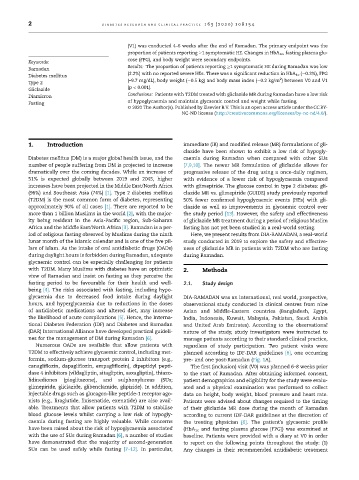Page 73 - Diamicron MR MIG Cycle 2(20-21) Final
P. 73
2 di ab e t es re s e ar ch and c lin i c a l p ra ct ic e 16 3 (20 20) 1 0815 4
(V1) was conducted 4–6 weeks after the end of Ramadan. The primary endpoint was the
proportion of patients reporting 1 symptomatic HE. Changes in HbA 1c , fasting plasma glu-
cose (FPG), and body weight were secondary endpoints.
Keywords:
Results: The proportion of patients reporting 1 symptomatic HE during Ramadan was low
Ramadan
(2.2%) with no reported severe HEs. There was a significant reduction in HbA 1c ( 0.3%), FPG
Diabetes mellitus
2
(–9.7 mg/dL), body weight ( 0.5 kg) and body mass index ( 0.2 kg/m ) between V0 and V1
Type 2
Gliclazide (p < 0.001).
Conclusions: Patients with T2DM treated with gliclazide MR during Ramadan have a low risk
Diamicron
Fasting of hypoglycaemia and maintain glycaemic control and weight while fasting.
Ó 2020 The Author(s). Published by Elsevier B.V. This is an open access article under the CC BY-
NC-ND license (http://creativecommons.org/licenses/by-nc-nd/4.0/).
1. Introduction immediate (IR) and modified release (MR) formulations of gli-
clazide have been shown to exhibit a low risk of hypogly-
Diabetes mellitus (DM) is a major global health issue, and the caemia during Ramadan when compared with other SUs
number of people suffering from DM is projected to increase [7,9,10]. The newer MR formulation of gliclazide allows for
dramatically over the coming decades. While an increase of progressive release of the drug using a once-daily regimen,
51% is expected globally between 2019 and 2045, higher with evidence of a lower risk of hypoglycaemia compared
increases have been projected in the Middle East/North Africa with glimepiride. The glucose control in type 2 diabetes: gli-
(96%) and Southeast Asia (74%) [1]. Type 2 diabetes mellitus clazide MR vs. glimepiride (GUIDE) study previously reported
(T2DM) is the most common form of diabetes, representing 50% fewer confirmed hypoglycaemic events (HEs) with gli-
approximately 90% of all cases [1]. There are reported to be clazide as well as improvements in glycaemic control over
more than 1 billion Muslims in the world [2], with the major- the study period [13]. However, the safety and effectiveness
ity being resident in the Asia-Pacific region, Sub-Saharan of gliclazide MR treatment during a period of religious Muslim
Africa and the Middle East/North Africa [3]. Ramadan is a per- fasting has not yet been studied in a real-world setting.
iod of religious fasting observed by Muslims during the ninth Here, we present results from DIA-RAMADAN, a real-world
lunar month of the Islamic calendar and is one of the five pil- study conducted in 2019 to explore the safety and effective-
lars of Islam. As the intake of oral antidiabetic drugs (OADs) ness of gliclazide MR in patients with T2DM who are fasting
during daylight hours is forbidden during Ramadan, adequate during Ramadan.
glycaemic control can be especially challenging for patients
with T2DM. Many Muslims with diabetes have an optimistic 2. Methods
view of Ramadan and insist on fasting as they perceive the
fasting period to be favourable for their health and well- 2.1. Study design
being [4]. The risks associated with fasting, including hypo-
glycaemia due to decreased food intake during daylight DIA-RAMADAN was an international, real world, prospective,
hours, and hyperglycaemia due to reductions in the doses observational study conducted in clinical centres from nine
of antidiabetic medications and altered diet, may increase Asian and Middle-Eastern countries (Bangladesh, Egypt,
the likelihood of acute complications [5]. Hence, the Interna- India, Indonesia, Kuwait, Malaysia, Pakistan, Saudi Arabia
tional Diabetes Federation (IDF) and Diabetes and Ramadan and United Arab Emirates). According to the observational
(DAR) International Alliance have developed practical guideli- nature of the study, study investigators were instructed to
nes for the management of DM during Ramadan [6]. manage patients according to their standard clinical practice,
Numerous OADs are available that allow patients with regardless of study participation. Two patient visits were
T2DM to effectively achieve glycaemic control, including met- planned according to IDF-DAR guidelines [6], one occurring
formin, sodium-glucose transport protein 2 inhibitors (e.g., pre- and one post-Ramadan (Fig. 1A).
canagliflozin, dapagliflozin, empagliflozin), dipeptidyl pepti- The first (inclusion) visit (V0) was planned 6–8 weeks prior
dase 4 inhibitors (vildagliptin, sitagliptin, saxagliptin), thiazo- to the start of Ramadan. After obtaining informed consent,
lidinediones (pioglitazone), and sulphonylureas (SUs; patient demographics and eligibility for the study were evalu-
glimepiride, gliclazide, glibenclamide, glipizide). In addition, ated and a physical examination was performed to collect
injectable drugs such as glucagon-like peptide-1 receptor ago- data on height, body weight, blood pressure and heart rate.
nists (e.g., liraglutide, lixisenatide, exenatide) are also avail- Patients were advised about changes required to the timing
able. Treatments that allow patients with T2DM to stabilise of their gliclazide MR dose during the month of Ramadan
blood glucose levels whilst carrying a low risk of hypogly- according to current IDF-DAR guidelines at the discretion of
caemia during fasting are highly valuable. While concerns the treating physician [6]. The patient’s glycaemic profile
have been raised about the risk of hypoglycaemia associated (HbA 1c and fasting plasma glucose [FPG]) was examined at
with the use of SUs during Ramadan [6], a number of studies baseline. Patients were provided with a diary at V0 in order
have demonstrated that the majority of second-generation to report on the following points throughout the study: (1)
SUs can be used safely while fasting [7–12]. In particular, Any changes in their recommended antidiabetic treatment

